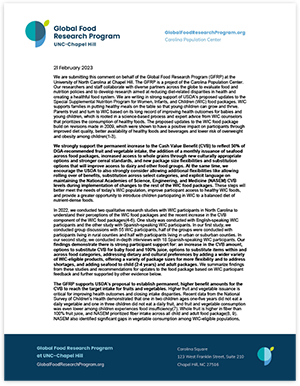The US Food and Drug Administration (FDA) is seeking to create a national definition of ultra-processed foods (UPFs) for policy and regulation. These comments, submitted by Drs. Marissa Hall, Shu Wen Ng, Barry Popkin, and Lindsey Smith Taillie on behalf of the Global Food Research Program at UNC-Chapel Hill, emphasize that UPFs make up over half of US calorie intake and are strongly linked to chronic diseases, overeating, and poor health outcomes. GFRP urges the FDA to use evidence-based criteria that reflect the systems used in scientific research and to ensure the definition is practical, consistent, and comprehensive. Their key recommendations include to:
- Use the Nova classification system as the foundation for defining UPFs;
- Identify UPFs through ingredient lists and additives rather than industrial processing data;
- Focus on the presence, not amount, of “cosmetic” additives such as colors, flavors, emulsifiers, and sweeteners;
- Avoid defining UPFs solely by nutrient content or individual ingredients;
- Use nutrient thresholds (sugar, sodium, saturated fat) only as secondary, supportive criteria; and
- Keep definitions broad enough to capture most UPFs and prevent industry reformulation loopholes.
